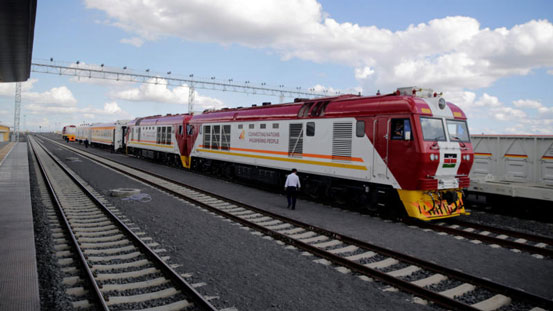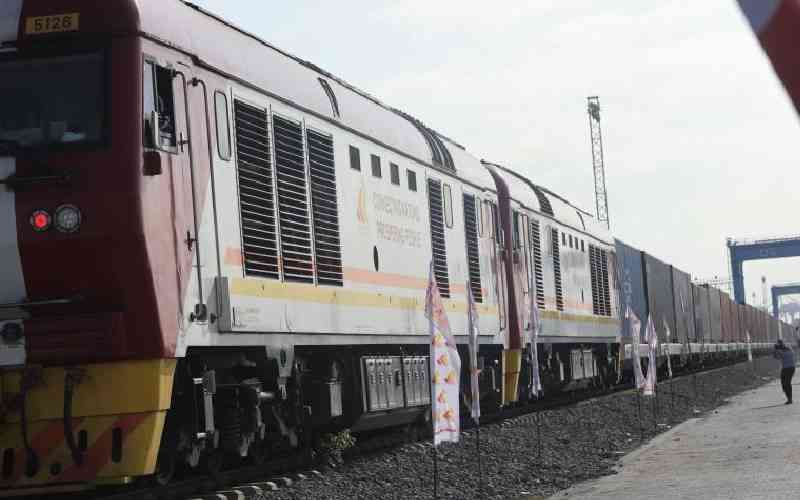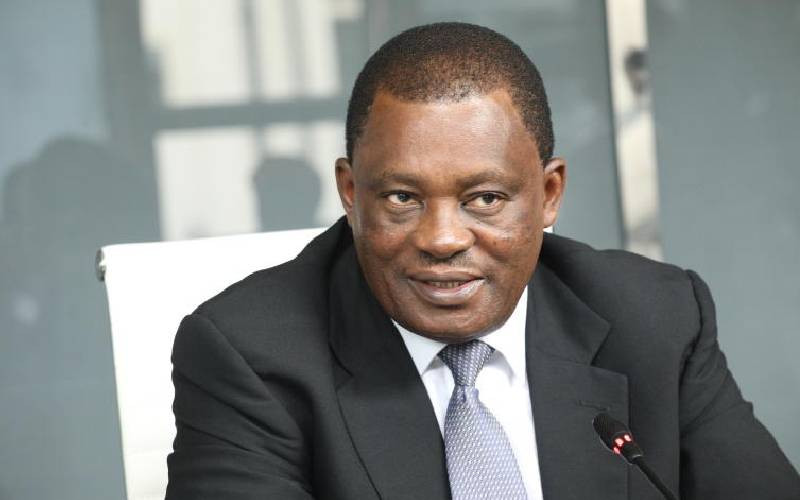
A train launched to operate on the Standard Gauge Railway (SGR) line constructed by the China Road and Bridge Corporation (CRBC) and financed by Chinese government arrives at the Nairobi Terminus on the outskirts of Kenya's capital Nairobi May 31, 2017
The Monitoring and Evaluation Department has never appraised major mega projects including the Thika Superhighway and the Standard Gauge Railway (SGR) owing to turf wars, inadequate personnel and low funding.
The head of the Monitoring and Evaluation (M&E) department at the Ministry of Devolution and Planning Dr Samson Machuka explains that his department, which is tasked with evaluating major government infrastructural projects, is at a loss as far as evaluating these projects to determine there returns to the economy is concerned.
“Some of these major projects like the Thika Superhighway and the SGR are not yet evaluated since the department that I head has neither the proper funding nor the human resource capacity to carry out the evaluation,” Dr Machuka explains.
Machuka avers that his department hopes that the next parliament will pass a recommendation whereby one per cent of the development budget will go to monitoring and evaluation of government infrastructural projects.
Dr Machuka is also optimistic that his department will be empowered by an act of parliament to graduate from just another policy think-tank at the ministry of planning to an impact-based department .
Apart from inadequate human capacity and funding, the department has also suffered infighting from different ministries as well as lack of recognition from county governments.
“We have encountered a lot of resistance from ministries which do not want to release their reports for evaluation. County governments also think we are intruding into their realms when we ask for reports to evaluate their projects. They feel we don’t recognise their autonomy,” Machuka asserts.
Under Vision 2010, a total of 11,300km (7000 miles) of roads were targeted for tarmacking when Narc Government took power including the grandiose modification of the 50.4km Thika highway into a super highway at a cost of Sh31 billion.
After the completion of this mega-infrastructural project, other equally big projects have come with the icing on the cake being the Sh327 billion SGR from Mombasa to Nairobi that has just been completed.
However, a recent forum hosted by the Africa Development Bank (AfDB) which brought together players from the Ministry of Devolution and Planning and the private sector concluded that most Kenyans are unaware of how key infrastructural projects have contributed to their economic well-being.
Huge funding
Also yet to be known are the returns of these projects given the huge funding they have received, especially through credit.
Walter Owour, an economist at AfDB and one of the participants at the forum explained that his bank, which funded Thika Super Highway to a tune of over Sh18 billion, is yet to know whether the Kenyan government has done any evaluation to ascertain how the super highway has contributed positively to the economic well being of Kenyans.
Stay informed. Subscribe to our newsletter
“We at AFDB did an evaluation of the Thika superhighway and concluded that the project, while intended to a have an impact such that its economic returns would be felt by every Kenyan, it has turned out to be of gain to a few people who had made investments along the highway,” Mr Owour said.
The AFDB economist said if the Kenyan government had made any meaningful evaluation of the project, then its findings would have perhaps contradicted AFDB’s conclusions and painted a more favourable picture of the superhighway investment.
AfDB has approved funds close to $1 billion (Sh100 billion) for the development of roads, energy and water projects in Kenya over the next five years.
Apart from Thika Super Highway, the bank has also funded the upgrade of Outer Ring Road to a dual carriageway and geothermal projects in the Rift Valley.
Still, none of these projects have undergone clear evaluation from the Kenyan government as Owuor asserts.
Mr Machuka disclosed that the only initiative that has been properly evaluated by his department is the County Development Fund.
The evaluation was carried out through sampling 18 constituencies selected randomly: Westlands, Kariobangi South, Kajiado North, Machakos Town, Maragua, Nyeri Town and Isiolo North.
Others are Igembe South, Runyejes, Naivaisha, Nyaribari Chache, Kisumu East, Ikolomani, Butere, Sirisa, Kwanza, Eldoret East and Baringo Central.
The research methodology included Focus Group Discussions and face to face interviews.
The study established that CDF can be strengthened by reviewing the management structures and putting in place mechanisms for implementation of affirmative action for marginalised and vulnerable groups.
Efficiency and effectiveness could be increased by proper coordination and management of all the developed funds so as to avoid duplication of projects and double claiming.
The study concluded that majority of the people are aware of CDF funds and activities. However a small percentage of people are aware of CDF regulations.
 The Standard Group Plc is a
multi-media organization with investments in media platforms spanning newspaper
print operations, television, radio broadcasting, digital and online services. The
Standard Group is recognized as a leading multi-media house in Kenya with a key
influence in matters of national and international interest.
The Standard Group Plc is a
multi-media organization with investments in media platforms spanning newspaper
print operations, television, radio broadcasting, digital and online services. The
Standard Group is recognized as a leading multi-media house in Kenya with a key
influence in matters of national and international interest.
 The Standard Group Plc is a
multi-media organization with investments in media platforms spanning newspaper
print operations, television, radio broadcasting, digital and online services. The
Standard Group is recognized as a leading multi-media house in Kenya with a key
influence in matters of national and international interest.
The Standard Group Plc is a
multi-media organization with investments in media platforms spanning newspaper
print operations, television, radio broadcasting, digital and online services. The
Standard Group is recognized as a leading multi-media house in Kenya with a key
influence in matters of national and international interest.










